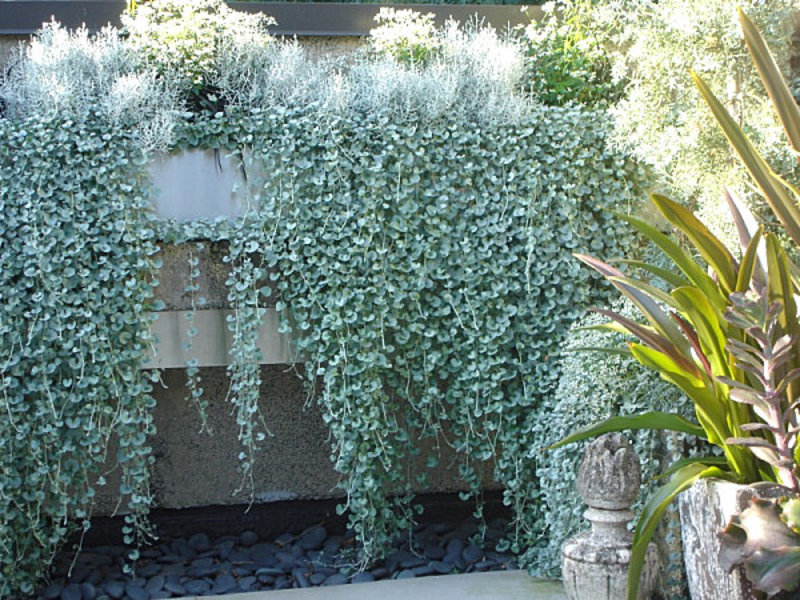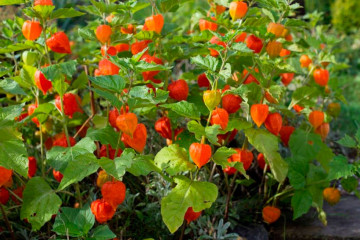Growing dichondra Emerald Falls and Silvery Falls
Content:
Dichondra is used in the garden as an alternative to lawn grass. In landscape design, it is popular for decorating an alpine slide, it is used as a background for other brightly flowering plants.
Dichondra Silvery Falls: growing
A distinctive feature of the dichondra plant "Silver Waterfall" is the branchy stems strewn with silver leaves. Most often grown in pots or pots, decorating balconies, loggias, verandas, garden corners.
Features of growing from seeds
Creeping dichondra reproduces vegetatively and by seeds. It is grown from seeds to obtain a large number of specimens at the same time.
Dichondra ampelous cultivation from seeds at home
Growing dichondra creeping from seeds begins in January or February. Seedling containers are used wide and shallow, the seeds are laid to a depth of 5 mm.
When real leaves are formed, the shoots dive, placing 2-3 copies in one pot. And when it gets warmer outside, they can be taken out onto the balcony every day, increasing the time spent outdoors, thus adapting the plant to the environment.
Dichondra grows slowly, the plant acquires decorative qualities after 3 months. That is why it is necessary to sow seeds in open ground as early as possible, since the shoots will only get stronger by autumn.
Dichondra: planting and care in the open field
It all starts with choosing a location. The plant loves the sun, therefore both at home and on the site it is planted on the south side. When planting dichondra in glanders, a distance of 35 cm is observed between the shoots; at home, a more compact planting is used in the pots.
Dichondra grown from seeds can grow on any soil, but it likes drained loamy or peaty more. When planting at the root, you can apply a long-lasting fertilizer.
The earthen lump should be moderately moist, with an excess of moisture, the roots rot, with a shortage, the shoots dry out. To create the moisture that the silvery leaves love, they are sprayed daily. Moist air gives an increase in green mass up to 25%.
Planting seedlings in pots
Dichondra is planted in pots in late May - early June, when the weather is warm. In colder climates, the transplant period is postponed to mid-June. A drainage layer must be placed on the bottom of the pot or pots.
Growing and caring for dichondra is not complete without pruning. To give the shoots a shape and increase their density, pinching is periodically done. In the summer, such procedures are carried out approximately every two weeks.
Dichondra Emerald Falls
The second known variety of dichondra is called Emerald Falls.Growing dichondra Emerald Falls is made from seeds and cuttings.
The second name of the variety is green dichondra, which the plant received thanks to its yellow-green leaves. The length of each leaf is 3 cm on average, the shoots are short. In its homeland, New Zealand, dichondra grows as a weed, and in other countries it is widely used in place of lawn cover. The Emerald Falls variety is less whimsical than the Silver Falls and can grow in the shade.
Dichondra: outdoor care
Landing in open ground is carried out in late May - early June, when the average daytime temperature is more than 20 ° C, and the night temperature is more than 15 ° C. The hole is made 3 cm deep, roots and 1/3 of the shoot should fit in it.
How to plant dichondra in open ground:
- keeping the distance between flowers 15 cm when growing dichondra as a ground cover flower;
- keeping the distance between flowers 40 cm when alternating with other flowers;
- there should be no flowers with a powerful root system nearby.
Top dressing for lush growth
When growing dichondra, fertilization is carried out during the growing season, universal or nitrogen fertilization is applied. In winter, additional nutrition is not required; in spring and summer, it is enough to apply additional fertilizing 2 times a month. If fertilizer gets on the leaves, rinse them with clean water to avoid burns.
Watering mode
Despite the fact that in the wild, the plant actively grows in swamps, it is easier to grow a plant in arid conditions than in wet conditions. For irrigation, settled warm water is used. Watering is necessary as needed, constantly maintaining the soil slightly moistened. The frequency of watering is influenced by the climate, air temperature, shoot size, planting density, location.
Wintering
For the winter, it needs to be covered, since the plant dies at low temperatures. Liana is able to endure winter only in a mild climate, the root system is close to the surface, so it immediately reacts to precipitation.
To protect the flower, the soil is covered with a layer of sawdust and foliage from 7 cm high, and the “lawn” can also be covered with a layer of soil and covered with foil. This is done before freezing. The second option is to transfer the plant, along with an earthen lump, to the basement or greenhouse, where the temperature is kept within 11-15 ° С.
Pests and diseases
Dichondra is resistant to diseases and to all parasites, except for the nematode. Less commonly, white aphids or whiteflies appear on the leaves. To cure the plant, the shoots are treated with an insecticide and the affected leaves are removed.
Dichondra in the interior and on the site will always give a zest. The gardener does not need to worry about the plant, it requires a minimum of attention and time, it is easier to care for it than for many other flowers.


















